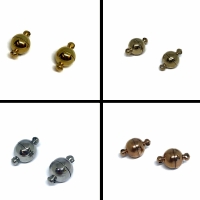Changing the Color of Metal in Jewelry process
Changing the Color of Metal In Jewelry process
Ever wondered how metal jewelry color change works? As a wholesale manufacturer of jewelry findings and other jewelry making materials, Sun Enterprises wants to dive deeper into the process of altering the color of metal jewelry, which involves several intriguing techniques, each with its own set of characteristics and effects.
Introduction to Changing Metal Color for Jewelry
Changing the color of metal in jewelry is a fascinating process that allows for endless design possibilities. There are several methods to achieve this, each with its unique process and results. This guide will walk you through the most popular techniques, including plating, oxidation, and alloying, so you can choose the best method for your project.

Methods to Change Metal Color
1. Plating
Plating involves applying a thin layer of metal onto the surface of a different metal. This method is commonly used to coat less expensive metals with precious metals like gold or silver.
Materials Needed:
- Base metal jewelry piece
- Plating solution (e.g., gold, silver, rhodium)
- Electroplating kit (anode, cathode, power supply)
- Cleaning solution
Process:
- Clean the Metal: Thoroughly clean the base metal to remove any dirt, oil, or oxidation.
- Prepare the Electroplating Setup: Follow the instructions on your electroplating kit to set up the anode, cathode, and power supply.
- Dip in Plating Solution: Submerge the base metal jewelry in the plating solution.
- Apply Electrical Current: Turn on the power supply to start the electroplating process. The electrical current will deposit the plating metal onto the base metal.
- Rinse and Dry: After the desired thickness is achieved, rinse the jewelry piece in water and dry it thoroughly.
2. Oxidation
Oxidation is a chemical process that induces a controlled reaction on the surface of the metal to change its color. This method is often used to create antique or vintage looks.
Materials Needed:
- Base metal jewelry piece (commonly silver or copper)
- Liver of sulfur or other oxidizing agent
- Cleaning solution
- Protective gloves and eyewear
Process:
- Clean the Metal: Clean the jewelry piece to ensure it's free of any contaminants.
- Prepare the Oxidizing Solution: Mix the liver of sulfur with water according to the product instructions.
- Submerge the Metal: Dip the jewelry piece into the oxidizing solution until the desired color is achieved.
- Rinse and Dry: Rinse the piece in water and dry it. You can also polish certain areas to create highlights and lowlights.
3. Alloying
Alloying involves mixing two or more metals to create a new metal with a different color. This is a more complex process and typically requires casting.
Materials Needed:
- Metals to be alloyed (e.g., gold and copper for rose gold)
- Crucible and furnace
- Casting mold
- Protective gear (gloves, mask, eyewear)
Process:
- Choose Your Metals: Select the metals you want to alloy based on the desired color.
- Prepare the Furnace: Heat the furnace to the melting point of the highest melting metal.
- Melt the Metals: Place the metals in the crucible and melt them together.
- Pour into Mold: Once fully melted, pour the alloy into a casting mold.
- Cool and Polish: Allow the metal to cool, then polish it to bring out its new color.
Tips for Choosing the Right Method
- Plating is best for adding a thin layer of precious metal to a base metal piece, ideal for budget-friendly projects.
- Oxidation works well for achieving antique finishes and is suitable for metals like silver and copper.
- Alloying is the go-to method for creating entirely new metal colors and is perfect for custom pieces requiring specific color tones.
Safety Precautions
When working with chemicals or heat, always follow safety guidelines:
- Wear protective gloves, eyewear, and masks.
- Work in a well-ventilated area.
- Follow the manufacturer's instructions for all chemicals and equipment.
Before and After Examples
To inspire your creativity, here are some before and after images showcasing the transformation of metal jewelry using the different methods:
- Plating: A brass ring transformed into a gleaming gold piece.
- Oxidation: A silver bracelet given a vintage patina finish.
- Alloying: Copper and gold alloyed to create a beautiful rose gold pendant.
Conclusion
Changing the color of metal in jewelry offers endless possibilities for customization and creativity.
Discover Our Vibrant Collection

At Sun Enterprises, we offer an extensive array of products in various colors, crafted from different metals to suit every jewelry-making need. Our collection includes an assortment of high-quality jewelry findings and jewelry making materials, providing designers the freedom to create extraordinary and unique pieces. Visit our collection today to explore the vibrant possibilities and enhance your jewelry creations with our diverse range of metal colors and finishes.













































